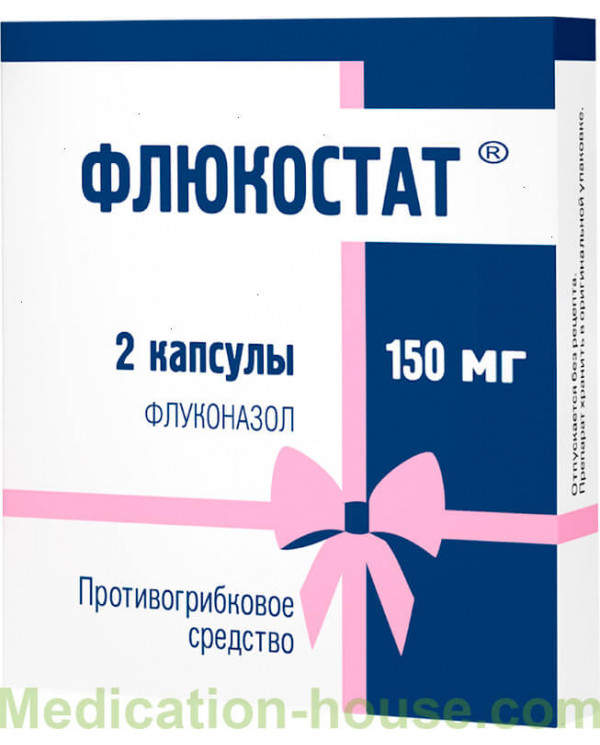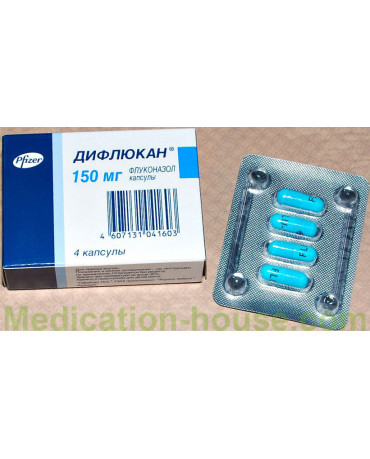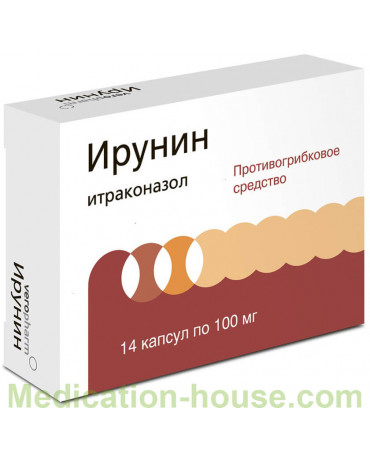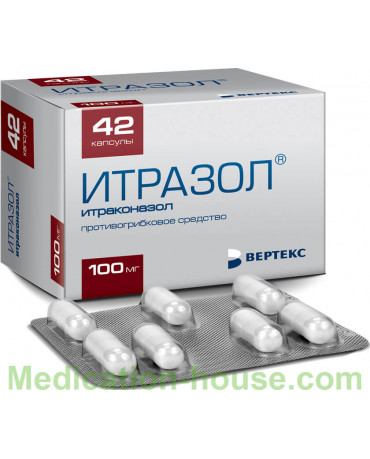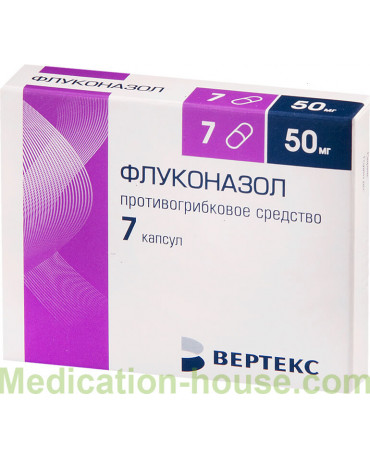Instruction for Flucostat
You can buy Flucostat here
It is necessary to take a disposable tablet Flucostat - and from the surface of the mucous membrane not only in the vagina, but also in the mouth and intestines are eliminated mushrooms. For the treatment of cryptococcal infections for 6-8 weeks, it is necessary to take 200-400 mg of the drug. Children for the prevention and treatment of candidiasis are prescribed for 3-12 μg of flucostat per day.
According to doctors, Flucostat capsules are very well absorbed. Their bioavailability is ninety percent, so it is not recommended to exceed the dosage. Most often, one pint per day is enough, and at the early stage one trick is enough. It does not matter if you drank a pill with food or not. It is assimilated equally well. Their body is derived fluconazole through the kidneys. Almost 80 percent comes out with urine.
Composition and release form
Flucostat capsules have an oblong shape, pink (dosage 50 mg) or white (dosage 150 mg) color.
The main active ingredient of the drug is fluconazole, its content in 1 capsule is 50 or 150 mg.
It also includes auxiliary components, which include:
Corn starch.
Acetic acid.
Iron oxide red.
Sodium lauryl sulfate.
Methyl parahydroxybenzoate.
Lactose.
Colloidal silicon dioxide.
Titanium dioxide.
Propyl parahydroxybenzoate.
Gelatin.
Gelatin.
Magnesium stearate.
Flucostat capsules are packaged in blisters in the amount of 1 piece (dosage 150 mg) or 7 pieces (dosage 50 mg). The carton pack contains 1 blister pack with the appropriate number of capsules and dosage, as well as instructions for use of the drug.
Pharmacological effect
The drug is a selective inhibitor of the synthesis of sterols in the cell of fungi. It has a high specificity against fungal enzymes dependent on cytochrome P450.
Fluconazole is active against various models of fungal infections in animals, including infections caused by Blastomyces dermatitidis, Coccidioides immitis, including intracranial infections, and Histoplasma capsulatum in animals with normal and reduced immunity.
Fluconazole is effective in opportunistic mycoses, incl. caused by Candida spp., including generalized candidiasis in immunocompromised animals; Cryptococcus neoformans, including intracranial infections; Microsporum spp. and Trychoptyton spp.
Indications for use
The main medical indication for receiving Flucostat capsules is etiotropic therapy (treatment aimed at destroying the causative agent of the infectious process) of fungal diseases caused by pathogens that are susceptible to the active substance of the drug:
Various fungal infections of the skin, including mycoses of the feet, trunk, groin, onychomycosis, lichen planus.
Genital candidiasis (thrush) with a severe infection process that is not amenable to treatment with medicinal antifungal agents for local use, including candidiasis of the vagina in women or the head of the penis in men.
Candidiasis of the mucous membranes, including localized in the mouth, pharynx, esophagus, trachea, urinary system structures.
Cryptococcosis, including fungal damage to the lining of the brain. The drug is used to treat this fungal disease in patients with normal and reduced immunity.
Generalized candidiasis - the spread of the infectious process in various organs and tissues, which often develops against the background of a pronounced decrease in the functional activity of the immune system.
A group of fungal infections represented by deep endemic mycoses, including paracoccidioidomycosis, coccidiomycosis, histoplasmosis, sporotrichosis in patients with normal or reduced immunity.
Also, the drug is used to prevent the development of fungal infections in patients with reduced functional activity of the immune system on the background of the oncological process and treatment with cytostatics.
Contraindications
Severe contraindications include the following conditions:
children up to 3 years;
galactosemia;
increased individual sensitivity to the active ingredient or excipients;
glucose-galactose malabsorption syndrome;
lactose intolerance (including lactase deficiency);
hereditary or acquired intolerance to the components of a pharmaceutical preparation;
Combined use of Flucostat with drugs that prolong the QT interval on an electrocardiogram (in particular, astemizole or terfenadine).
The list of non-absolute contraindications should also be outlined when the medicine should be used with caution (it is recommended that conservative therapy be followed under the supervision of qualified medical personnel):
kidney or liver failure;
alcoholism;
treatment with potentially dangerous pharmaceutical preparations with a high percentage of hepatotoxicity;
proarrhythmic conditions (especially if the patient has multiple risk factors for the development of arrhythmia).
Appointment during pregnancy and lactation
During the use of the drug, the active active ingredients are absorbed into the main bloodstream and spread throughout the woman’s body, evenly deposited in biological fluids. That is why the use of the antifungal drug Flucostat during pregnancy is allowed solely for health reasons (for example, in the case of severe, generalized infections that threaten the life of the expectant mother and fetus).
If there is a need to undergo a course of conservative therapy during breastfeeding, then the child should be weaned from the breast and breast milk, because even in such a specific secret traces of biologically active substances are found that make up the enteral and parteral forms of Flucomestat.
Dosage and method of use
As indicated in the instructions for use, coated capsules and tablets are used enterally, that is, inside. They should be swallowed whole, without compromising integrity, this may affect the therapeutic efficacy of treatment. How to take - before or after a meal - does not matter, since the absorption of the active components of the Flucostat does not depend on the filling of the lumen of the digestive tube. The duration of treatment is selected individually, as a rule, conservative therapy is carried out until the results of microbiological studies of the pathological focus are completely negative.
The dosage of the pharmaceutical product and the treatment regimen depends on the clinical diagnosis:
Pityriasis versicolor - 50 mg 1 time per day for 2-4 weeks;
Thrush and balanitis - 150 mg once, and then for the prevention of relapse 150 mg 1 time per month for 4-12 months;
Deep endemic mycoses - 200-400 mg per day (duration depends on the pathogenic fungus that caused the disease);
Atrophic oral candidiasis and similar infections of the mucous membranes - 50-100 mg / day for 14-30 days;
Skin mycoses - 150 mg 1 time per week or 50 mg 1 time per day for 2-6 weeks, depending on the sensitivity of the pathogen to therapy;
Onychomycosis - 150 mg 1 time per week until the non-affected nail plate is fully renewed (nails grow on hands for 3-6 months, and on legs for 6-12 months);
Cryptococcal infections, disseminated candidiasis and the ingress of fungi in the blood - the first day 400 mg, and then 200-400 mg 1 time per day for a long period.
In children, the dosage of the drug varies from 3 to 12 mg per 1 kg of body weight per day, it is determined by the doctor individually, depending on the severity of the fungal infection, the age and weight of the child. Also in most cases, the duration of the course of therapy is set by the doctor for adult patients.
Adverse reactions
When taking the drug, the following side effects are possible:
Hematopoietic system: rarely - thrombocytopenia, leukopenia, agranulocytosis.
Metabolism: rarely - hypertriglyceridemia, hypercholesterolemia, hypokalemia.
Allergic manifestations: skin rash; rarely - anaphylactoid reactions (including skin itch, swelling of the face, angioedema, urticaria), toxic epidermal necrolysis (Lyell's syndrome), malignant exudative erythema (including Stevens-Johnson syndrome).
Severe dizziness, headache, convulsions (rare) - the central nervous system.
Cardiovascular system: flutter, ventricular fibrillation, increase in the duration of the QT interval.
The digestive system: bouts of nausea, vomiting, flatulence, diarrhea, abdominal pain, change in taste; rarely, functional impairment of the liver (hepatitis, jaundice, hyperbilirubinemia, hepatonecrosis, elevated serum aminotransferase levels, alkaline phosphatase level).
Other: rarely - alopecia, a functional renal disorder.
Overdose
In case of a significant excess of the recommended therapeutic dose of Flyudecite capsules, signs of negative pathological reactions appear or increase. In this case, the stomach and intestines are washed, intestinal sorbents are prescribed, and if necessary, symptomatic therapy is carried out in a medical hospital.
special instructions
Care must be taken with simultaneous use of Flucostat with cisapride, astemizole, rifabutin, tacrolimus or other drugs metabolized by cytochrome P450 isoenzymes.
AIDS patients are more likely to develop severe skin reactions with the use of many drugs. When a rash appears in a patient receiving treatment for a superficial fungal infection, which can be associated with Flucostat, the drug should be discontinued. When a rash appears in patients with invasive / systemic fungal infections, they should be carefully monitored and fluconazole should be canceled when there is a bullous lesion or erythema multiforme.
In rare cases, the use of Flucostat was accompanied by toxic changes in the liver, including fatal, mainly in patients with serious comorbidities. There is no apparent dependence of the frequency of development of the hepatotoxic effects of fluconazole on the total daily dose, duration of therapy, sex and age of the patient. The hepatotoxic effect of fluconazole is usually reversible; his symptoms disappeared after cessation of therapy. If clinical signs of liver damage appear that may be associated with fluconazole, the drug should be withdrawn.
Compatibility with other drugs
When using the drug, you must consider the interaction with other drugs:
With simultaneous use of Flucostat and zidovudine, there is an increase in plasma zidovudine concentration, which is caused by a decrease in the conversion of the latter into its metabolite.
The simultaneous use of Flucostat with midazolam increases the risk of psychomotor effects, with tacrolimus increases the risk of nephrotoxicity.
Patients receiving theophylline in high doses, or who are likely to develop theophylline intoxication, should be monitored for early detection of symptoms of an overdose of theophylline, because simultaneous reception of Flucostat leads to a decrease in the average rate of clearance of theophylline from plasma.
With the simultaneous use of Flucostat and terfenadine or cisapride, cases of undesirable reactions of the heart are described, including paroxysmal ventricular tachycardia (“pirouette” arrhythmias).
There are reports of the interaction of Flucostat and rifabutin, accompanied by an increase in serum levels of the latter. With the simultaneous use of Flucostat and rifabutin, cases of development of uveitis are described. It is necessary to carefully observe patients who simultaneously receive rifabutin and fluconazole.
When using Flucostat with warfarin, an increase in prothrombin time was noted by 12%. In this regard, it is recommended to control the prothrombin time in patients receiving Flucostat in combination with coumarin anticoagulants.
With simultaneous use of Flucostat increases T1 / 2 oral hypoglycemic drugs - sulfonylurea derivatives (chlorpropamide, glibenclamide, glipizida and tolbutamide). The joint appointment of Flucostat and oral hypoglycemic drugs is allowed, but it should take into account the possibility of the development of hypoglycemia.
The simultaneous use of fluconazole and phenytoin may be accompanied by an increase in the concentration of phenytoin in a clinically significant degree. Therefore, if necessary, the combined use of these drugs requires monitoring the concentration of phenytoin with the correction of its dose in order to ensure therapeutic plasma concentrations.
The simultaneous use of Flucostat and rifampicin leads to a decrease in AUC by 25% and shortening of T1 / 2 Flucostat from plasma by 20%. Therefore, in patients receiving rifampicin at the same time, the dose of Flucostat is recommended to be increased.
It is recommended to control the concentration of cyclosporine in the blood of patients receiving Flucostat, since with the use of Flucostat and cyclosporine in patients with a transplanted kidney, taking Flucostat at a dose of 200 mg / day leads to a slow increase in plasma concentration of cyclosporine.
Reviews
We offer you to read the reviews of people who used Flucostat:
Irina
At first I was afraid to spend money, bought cheap “Fluconazole” for 40 rubles. The effect, of course, was, but after some time I had to run to the pharmacy again. This time did not save and do not regret. One capsule was enough. That seems to be the same active ingredients, and the effect is different. Already self-conviction or whatever, but now only Flucostat.
Svetlana
Flucostat saved me. The day before yesterday I could not sleep peacefully, toss and turn, worried. I thought - how much will it cost. As a result, my full recovery cost me 170 rubles! By evening yesterday, there was noticeably less discharge, this morning the discomfort and the rest of the discharge passed. Great tool.
Margarita
I had a scaly on the arm, it was unpleasant and scary that he would develop further. The doctor prescribed me Flucostat capsules. Before taking them, I read the reviews and concluded that they were worthwhile. On the first day I took the maximum dose. The next day - reduced, as the doctor said. For a month of struggle, I managed to defeat the disease.
Terms of sell
You don't need a prescription to buy Flucostat.

